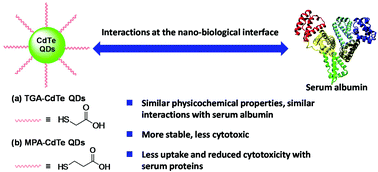当前位置:
X-MOL 学术
›
Toxicol. Res.
›
论文详情
Our official English website, www.x-mol.net, welcomes your
feedback! (Note: you will need to create a separate account there.)
The interactions of CdTe quantum dots with serum albumin and subsequent cytotoxicity: the influence of homologous ligands†
Toxicology Research ( IF 2.2 ) Pub Date : 2018-01-11 00:00:00 , DOI: 10.1039/c7tx00301c Ren Yan 1, 2, 3, 4, 5 , Bing-Qiong Yu 1, 2, 3, 4, 5 , Miao-Miao Yin 1, 2, 3, 4, 5 , Zhi-Qiang Zhou 1, 2, 3, 4, 5 , Xun Xiang 1, 2, 3, 4, 5 , Xiao-Le Han 5, 6, 7, 8 , Yi Liu 1, 2, 3, 4, 5 , Feng-Lei Jiang 1, 2, 3, 4, 5
Toxicology Research ( IF 2.2 ) Pub Date : 2018-01-11 00:00:00 , DOI: 10.1039/c7tx00301c Ren Yan 1, 2, 3, 4, 5 , Bing-Qiong Yu 1, 2, 3, 4, 5 , Miao-Miao Yin 1, 2, 3, 4, 5 , Zhi-Qiang Zhou 1, 2, 3, 4, 5 , Xun Xiang 1, 2, 3, 4, 5 , Xiao-Le Han 5, 6, 7, 8 , Yi Liu 1, 2, 3, 4, 5 , Feng-Lei Jiang 1, 2, 3, 4, 5
Affiliation

|
With spreading applications of fluorescent quantum dots (QDs) in biomedical fields in recent years, there is increasing concern over their toxicity. Among various factors, surface ligands play critical roles. Previous studies usually employed QDs with different kinds of surface ligands, but general principles were difficult to be obtained since it was hard to compare these surface ligands with varied chemical structures without common features. Herein, the physicochemical properties of two types of CdTe QDs were kept very similar, but different in the surface ligands with mercaptoacetic acid (TGA) and 3-mercaptopropionic acid (MPA), respectively. These two types of homologous ligands only had a difference in one methylene group (–CH2–). The interactions of the two types of CdTe QDs with bovine serum albumin (BSA), which was one of the main components of cell culture, were studied by fluorescence, UV-vis absorption, and circular dichroism spectroscopy. It was found that the fluorescence quenching of BSA by CdTe QDs followed a static quenching mechanism, and there was no obvious difference in the Stern–Volmer quenching constants and binding constants. The thermodynamic parameters of the two types of QDs were similar. BSA underwent conformational changes upon association with these QDs. By comparing the cytotoxicity of these two types of QDs, TGA-capped QDs were found to be less cytotoxic than MPA-capped QDs. Besides, in the presence of serum proteins, the cytotoxicity of the QDs was reduced. QDs in the absence of serum proteins had a higher internalization efficiency, compared with those in the medium with serum. To the best of our knowledge, this is a rare study focusing on surface ligands with such small variations at the biomolecular and cellular levels. These findings can provide new insights for the design and applications of QDs in complex biological media.
中文翻译:

CdTe量子点与血清白蛋白的相互作用及随后的细胞毒性:同源配体的影响†
近年来,随着荧光量子点(QD)在生物医学领域中的广泛应用,人们对其毒性越来越关注。在各种因素中,表面配体起着至关重要的作用。先前的研究通常使用具有不同种类表面配体的量子点,但由于难以比较具有不同化学结构而没有共同特征的这些表面配体,因此难以获得一般原理。在本文中,两种类型的CdTe QD的理化性质保持非常相似,但在分别带有巯基乙酸(TGA)和3-巯基丙酸(MPA)的表面配体上却有所不同。这两种类型的同源配体仅在一个亚甲基(–CH 2–)。通过荧光,紫外-可见吸收和圆二色光谱研究了两种类型的CdTe量子点与牛血清白蛋白(BSA)的相互作用,牛血清白蛋白是细胞培养的主要成分之一。发现CdTe量子点对BSA的荧光猝灭遵循静态猝灭机理,并且Stern-Volmer猝灭常数和结合常数没有明显差异。两种量子点的热力学参数相似。与这些QD关联后,BSA发生了构象变化。通过比较这两种类型的QD的细胞毒性,发现TGA封闭的QD的细胞毒性比MPA封闭的QD的细胞毒性小。此外,在血清蛋白的存在下,量子点的细胞毒性降低了。没有血清蛋白的量子点具有更高的内在化效率,与含血清的培养基相比。据我们所知,这是一项罕见的研究,重点是在生物分子和细胞水平上具有如此小的变化的表面配体。这些发现可以为复杂生物介质中量子点的设计和应用提供新的见解。
更新日期:2018-01-11
中文翻译:

CdTe量子点与血清白蛋白的相互作用及随后的细胞毒性:同源配体的影响†
近年来,随着荧光量子点(QD)在生物医学领域中的广泛应用,人们对其毒性越来越关注。在各种因素中,表面配体起着至关重要的作用。先前的研究通常使用具有不同种类表面配体的量子点,但由于难以比较具有不同化学结构而没有共同特征的这些表面配体,因此难以获得一般原理。在本文中,两种类型的CdTe QD的理化性质保持非常相似,但在分别带有巯基乙酸(TGA)和3-巯基丙酸(MPA)的表面配体上却有所不同。这两种类型的同源配体仅在一个亚甲基(–CH 2–)。通过荧光,紫外-可见吸收和圆二色光谱研究了两种类型的CdTe量子点与牛血清白蛋白(BSA)的相互作用,牛血清白蛋白是细胞培养的主要成分之一。发现CdTe量子点对BSA的荧光猝灭遵循静态猝灭机理,并且Stern-Volmer猝灭常数和结合常数没有明显差异。两种量子点的热力学参数相似。与这些QD关联后,BSA发生了构象变化。通过比较这两种类型的QD的细胞毒性,发现TGA封闭的QD的细胞毒性比MPA封闭的QD的细胞毒性小。此外,在血清蛋白的存在下,量子点的细胞毒性降低了。没有血清蛋白的量子点具有更高的内在化效率,与含血清的培养基相比。据我们所知,这是一项罕见的研究,重点是在生物分子和细胞水平上具有如此小的变化的表面配体。这些发现可以为复杂生物介质中量子点的设计和应用提供新的见解。











































 京公网安备 11010802027423号
京公网安备 11010802027423号